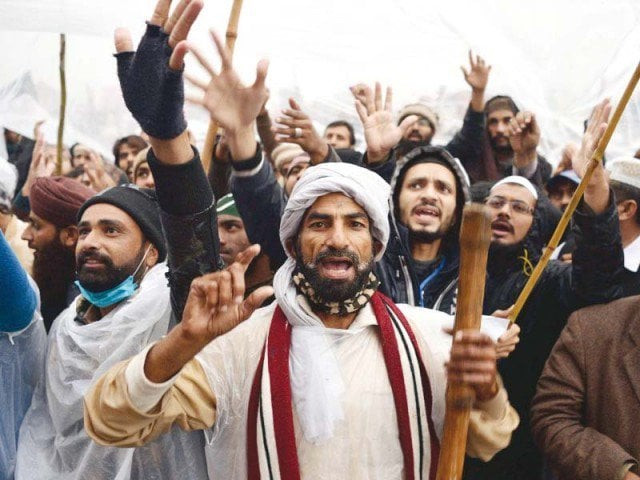ISI report spills beans on Faizabad dharna
Gives profiles of organisers, also identifies financiers of protest

PHOTO: EXPRESS
A two-member bench of the apex court, comprising Justice Mushir Alam and Justice Qazi Faez Isa, is resuming the hearing of a suo motu case regarding last year’s Faizabad sit-in today (Monday). Deputy Attorney General Sohail Mahmood will appear on behalf of the federal government.
Inter Service Intelligence (ISI) has submitted a comprehensive report, wherein it is stated that the ISI had recommended that the federal government avoid the use of force and resolve the issue peacefully through negations with Tehreek-e-Labbaik (TLYR).
Faizabad crackdown handed over to Rangers
“Despite ISI’s recommendations to solve the issue politically and avoid the use of force, an operation against the dharna was launched on November 25, 2017 on the orders of the Islamabad High Court. The operation was an utter failure [and] triggered countrywide protests,” says the report. A copy of the 46-page report is available with The Express Tribune.
The complete profiles of the leadership of the protesters – Rizvi, Dr Muhammad Ashraf Asif Jalali, and Pir Muhammad Afzal Qadri – have also been attached to the report.
The report states that Rizvi is “reportedly corrupt” when it comes to financial matters, but also that he appears to be living within his means. It also notes that he has shown an inclination towards misuse of power, the authorities, and resources.
Opposition welcomes end to Faizabad sit-in
He is also listed as being “arrogant” with his superiors, “harsh” with his subordinates, and “committed” to his cause.
His overall reputation is ‘unsatisfactory’.
Regarding Dr Jalali, the report describes him as being dubious, an opportunist, and a manipulator. His overall general reputation is also “unsatisfactory”. It also notes he violated an agreement with the Punjab government for not holding a public meeting at Nasir Bagh Lahore in connection with the Mumtaz Qadri Rehai movement. It also says he is actively involved in sectarian activities.
No negative point has been found in the profile of Muhammad Afzal Qadri.
The report reveals that the Punjab government did not make any attempt to obstruct or negotiate with protesters to stop them from reaching the federal capital last November.
Tehreek-e-Labbaik calls off Islamabad sit-in after govt accepts demands
“The protesters’ strength at Faizabad varied between 1,500 and 1,800, and locals occasionally joined them, especially on Friday. TLYR sustained the dharna for 20 days due to generous public support. [There were] rumours of organised logistic support to TLYR activists occupying Faizabad interchange in terms of food.”
The report also says that local police were neither willing nor capable of obstructing or preventing the logistic supplies.
The report says that the operation failed due to lack of coordination between police forces of the twin cities and the inability of the Rawalpindi police to block reinforcements. Live media coverage of the operation on TV as well as social media resulted in mobilisation not only in Rawalpindi and Islamabad but across the country as well.
It also says that religious sentiments of police personnel were exploited by TLYR leadership through their continuous speeches on loudspeakers.
Clear Faizabad, Islamabad admin told
The federal government did not independently contact TLYR leaders for negations when the dharna got prolonged and inaction was observed. The representatives of ISI engaged both sides and asked them to sit together to resolve the issue, says the report.
The ISI has also expressed dissatisfaction over the performance of other agencies. The special branch of police covered the dharna but restricted themselves to providing tactical information, strength, participation and other logistic aspects. Likewise, “Intelligence Bureau (IB) remained aloof, as no information or efforts were visible on the part of this agency.”
A high-level meeting at the PM office on November 22 unanimously decided to resolve the issue peacefully. ISI was given a lead role with complete authority to negotiate. During the meeting, the DG ISI said that even though the sit-in at Faizabad was numerically small, the TLYR had pockets of dedicated and committed followers all over the country and that peaceful negotiations were the only way forward, according to the minutes of that meeting, which were also attached with the report.
According to the minutes, Punjab Law Minister Rana Sanuallah informed the meeting that the Punjab government had followed a policy of restraint to avoid creating a law and order situation and that by November 22, negotiations were the only solution to the problem.
Faizabad protesters falling prey to foreign conspiracy: Ahsan Iqbal
Support for protesters
The report says that generous donations by people from across society, especially the Barelvi sect, sustained the dharna. “It is reported that Khadim Rizvi raised over Rs10 million before starting the march, he encouraged his followers to either accompany the march or contribute Rs300 per person.”
A large number of registered madaris affiliated with the group raised large sums in donations. During the dharna, many affluent persons from across the globe also contributed financially.
The report also says that food was also provided by the owner of the TV station Channel 92, Mian Abdul Rasheed of Faisalabad.
It is also informed that Awami Muslim League chief Sheikh Rasheed Ahmad, PML-Z chief Ejazul Haq, PTI Ulema Wing Islamabad, and PPP leader Sheikh Hameed supported the Faizabad sit-in. Also included on the list of supporters was columnist and TV commentator Oriya Maqbool Jan.
The report has also identified six lawyers and three trade union leaders as supporting the dharna, but it has not explained how they supported the protesters.
It also reports on a meeting between a British Muslim delegation and diplomats, a Spanish Muslim delegation meeting dharna participants, and other attendees.
The ISI has also furnished the details of 175 protests, which were held in 36 districts of Punjab after the operation.
Fatigue creeps into Faizabad sit-in
Electricity
A diesel generator was installed on the main container, while the rest of the power supply was managed using illegal connections to CDA power poles. A CDA standby generator was also being used, according to the report.
The generator on the main container was provided by Wali Sons, Lahore. Reportedly, the daily cost of running the generator was Rs80,000.
Monitoring social media
Giving specific answers to questions raised by the apex court in its January 3 order, the ISI has replied that TLYR is a registered political party and has taken part in the recent by-elections where it secured a considerable number of votes.
“TLYR is neither a banned organisation nor on the watch list, hence it was not placed under surveillance earlier. The organisation, like others, is however monitored for any extremist tendencies.”
The ISI has admitted that it monitors extremist groups and persons and “those who jeopardise the functioning of the state”.
Regarding the monitoring of social media, the report says that as per Pakistan Electronic Crimes Act (PECA), the Federal Investigation Agency (FIA) is authorised to monitor internet and social media activity. Some negative activities are, however, monitored by the ISI in the context of national security and necessary details are shared with FIA as and when required.



















COMMENTS
Comments are moderated and generally will be posted if they are on-topic and not abusive.
For more information, please see our Comments FAQ